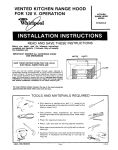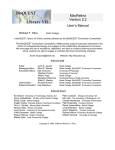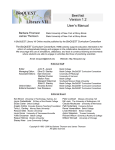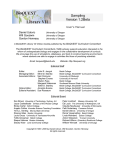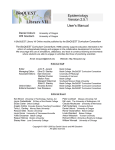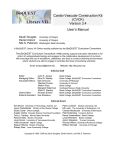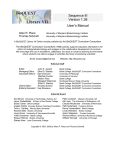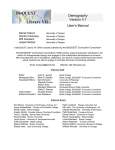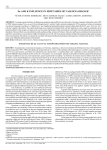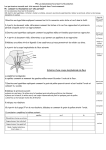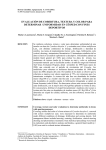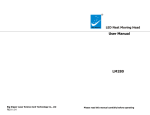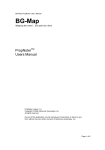Download Preview Software Manual - BioQUEST Curriculum Consortium
Transcript
Developmental Selection: Seed Abortion and Pollen Tube Competition User's Manual Donald Buckley Martin Cohen Quinnipiac University University of Hartford A BioQUEST Library VII Online module published by the BioQUEST Curriculum Consortium The BioQUEST Curriculum Consortium (1986) actively supports educators interested in the reform of undergraduate biology and engages in the collaborative development of curricula. We encourage the use of simulations, databases, and tools to construct learning environments where students are able to engage in activities like those of practicing scientists. Email: [email protected] Website: http://bioquest.org Editorial Staff Editor: Managing Editor: Associate Editors: John R. Jungck Ethel D. Stanley Sam Donovan Stephen Everse Marion Fass Margaret Waterman Ethel D. Stanley Online Editor: Amanda Everse Editorial Assistant: Sue Risseeuw Beloit College Beloit College, BioQUEST Curriculum Consortium University of Pittsburgh University of Vermont Beloit College Southeast Missouri State University Beloit College, BioQUEST Curriculum Consortium Beloit College, BioQUEST Curriculum Consortium Beloit College, BioQUEST Curriculum Consortium Editorial Board Ken Brown University of Technology, Sydney, AU Joyce Cadwallader St Mary of the Woods College Eloise Carter Oxford College Angelo Collins Knowles Science Teaching Foundation Terry L. Derting Murray State University Roscoe Giles Boston University Louis Gross University of Tennessee-Knoxville Yaffa Grossman Beloit College Raquel Holmes Boston University Stacey Kiser Lane Community College Peter Lockhart Massey University, NZ Ed Louis The University of Nottingham, UK Claudia Neuhauser University of Minnesota Patti Soderberg Conserve School Daniel Udovic University of Oregon Rama Viswanathan Beloit College Linda Weinland Edison College Anton Weisstein Truman University Richard Wilson (Emeritus) Rockhurst College William Wimsatt University of Chicago Copyright © 1993 -2006 by Donald Buckley and Martin Cohen All rights reserved. Copyright, Trademark, and License Acknowledgments Portions of the BioQUEST Library are copyrighted by Annenberg/CPB, Apple Computer Inc., Beloit College, Claris Corporation, Microsoft Corporation, and the authors of individually titled modules. All rights reserved. System 6, System 7, System 8, Mac OS 8, Finder, and SimpleText are trademarks of Apple Computer, Incorporated. HyperCard and HyperTalk, MultiFinder, QuickTime, Apple, Mac, Macintosh, Power Macintosh, LaserWriter, ImageWriter, and the Apple logo are registered trademarks of Apple Computer, Incorporated. Claris and HyperCard Player 2.1 are registered trademarks of Claris Corporation. Extend is a trademark of Imagine That, Incorporated. Adobe, Acrobat, and PageMaker are trademarks of Adobe Systems Incorporated. Microsoft, Windows, MS-DOS, and Windows NT are either registered trademarks or trademarks of Microsoft Corporation. Helvetica, Times, and Palatino are registered trademarks of Linotype-Hell. The BioQUEST Library and BioQUEST Curriculum Consortium are trademarks of Beloit College. Each BioQUEST module is a trademark of its respective institutions/authors. All other company and product names are trademarks or registered trademarks of their respective owners. Portions of some modules' software were created using Extender GrafPak™ by Invention Software Corporation. Some modules' software use the BioQUEST Toolkit licensed from Project BioQUEST. Table of Contents AN OVERVIEW OF THE SYSTEM . . . . . . . . . . . . . . . . . . . . . . . . . . . . . . . . . . . . . . . . . . . . . . . . . . . . . . . . . . . . . . 1 THE PROBLEM AND SEVERAL EXPLANATORY HYPOTHESES . . . . . . . . . . . . . . . . . . . . . . . 2 REPRODUCTIVE EXCESS AND EARLY SEED ABORTION ............................................................... 2 EXPLANATORY HYPOTHESES.................................................................................................. 2 Dispersal ........................................................................................................................ 2 Escaping Predators ........................................................................................................... 2 Developmental Selection................................................................................................... 2 Maternal Resource Limitation............................................................................................ 2 A NATURAL EXPERIMENT . . . . . . . . . . . . . . . . . . . . . . . . . . . . . . . . . . . . . . . . . . . . . . . . . . . . . . . . . . . . . . . . . . . . . . 2 THE DEVELOPMENTAL SELECTION SIMULATION, . . . . . . . . . . . . . . . . . . . . . . . . . . . . . . . . . . . . . . 3 SIMULATION SCREEN............................................................................................................ 3 EXPORT DATA...................................................................................................................... 5 INVESTIGATE AN UNKNOWN ................................................................................................... 5 SAMPLE LABORATORY USING DEVELOPMENTAL SELECTION . . . . . . . . . . . . . . . . . . . . . . 6 STATISTICAL ANALYSIS ........................................................................................................ 7 USING EXCEL AND CRICKET GRAPH TO CALCULATE AND PLOT MEANS AND STANDARD ERRORS, AND TO CONDUCT CORRELATION ANALYSIS........................................................................................ 9 Developmental Selection: Seed Abortion in Perennial Legumes A B C D An Overview of the System A. Pollen performance is influenced by the haploid genotype that they carry, as illustrated by these pollen grains stained with iodine to reveal their Waxy phenotype. B. Pollen tubes carry sperm from the pistil’s stigma (the receptive surface of the maternal reproductive structure) to the egg-bearing ovules in the ovary. C. The stigma and the ovary of a flower are separated by a long extension called a style, which may serve as a race track in which pollen performance is tested. There are often 7-20 pollen grains per ovule, which means that pollen tube growth may take assume the nature of a race to the eggs ...pollen tube competition. D. Pollen tube competition can influence the genetic quality of resulting seed progeny, such as in the legume fruits above. In many species, the affects of pollen tube competition can be viewed in the pattern of seed abortion within fruits. In fact, the signature of pollen tube competition may be used as a test of whether seed abortion is selective. The Problem and Several Explanatory Hypotheses Reproductive Excess and Early Seed Abortion Even in climax plant communities, where the reproductive requirement of a parent is only to replace itself with one successful offspring, parents may produce from hundreds to billions of offspring. In these perennial plants (species whose individuals live for more than one year), many or most seeds (and spores) are aborted before they mature. Explanatory Hypotheses Numerous hypotheses have been advanced to explain the evolutionary cause of this reproductive excess. Dispersal: Sites for the establishment of new offspring may be rare and/or randomly dispersed in space or time. Broadcasting a large number of offspring may be required to ensure dispersal into these recruitment sites, but this hypothesis doesn’t explain why numerous progeny abort before maturation. Escaping Predators: “Masting” plant species are the most extreme example of plants that reproduce much more intensively in some years than others. Years of low reproductive output are usually more common and serve to maintain predators at low population sizes. Infrequently, these plants greatly increase their reproductive output, to levels that exceed the harvesting capabilities of its predators, which ensures the escape of some progeny from predators. However, this hypothesis does not contribute to our understanding of why many progeny abort very young, without being able to serve as a “decoys” for predators. Developmental Selection: In many species, the over-production of inexpensive propagules is mechanism employed to screen genetically variable offspring. Many offspring are discarded by this kind of genetic testing, but the progeny that result are a kind of genetic elite. Pollen tube competition and seed abortion have been demonstrated to serve this function in numerous examples. Maternal Resource Limitation: Maternal resources may not be sufficient to mature the number of ovules fertilized earlier in the season. In such cases, seed abortion may be non-selective. The advantaged seeds may simply be the ones closest to maternal resources, preempting resources from competing seeds. A Natural Experiment In legume species, the arrangement of seed within fruits lends itself to the testing of the Developmental Selection and Maternal Resource Limitation hypotheses. Seeds are arranged in a linear array, with the style at one end of the row of seeds and the peduncle (the stalk through which the maternal parent provides resources to the seed within the fruit) at the other. 2 A dissected legume fruit, with mature (M) and aborted (A) seeds inside. Note that the seeds are arrayed in a row with the two pattern-producing structures located at opposite ends of the fruit. If pollen tube competition has sorted the genetic quality of the seed within the fruit, then the first fertilizations, involving the fastest-growing pollen tubes, should be in proximity to the site from which pollen tubes emerge from their race through the style and into the ovary. In most species that have been studied, the pollen tubes enter the ovary near the stylar or distal end of the fruit, which would result in a gradient of genetic quality within the fruit. If seed abortions are influenced by the genetic quality of the seeds, then seed maturation rates should be highest closest to the point of pollen tube entry into the ovary. Conversely, seed abortion may be non-selective. Perhaps proximity to the spigot, the fruit’s peduncle, matters most. Seeds at the base of the fruit may benefit from better nutrient access by being closer to the nutrient source, in which case, maturation rates should be highest at the base of the fruit, not the stylar end. The Developmental Selection Simulation, Developmental Selection is a research simulation. It is intended to provide practice in data collection, data analysis, and hypothesis testing. Double click the Developmental Selection application to launch it. Click on the title screen to advance into the simulation. Simulation Screen The simulation screen is divided into three areas (a–c): 3 a) b) c) a) Sliders Used to Control Biological Parameters. On the left of the screen you will see three sliders that let you modify seed/ovule ratios (the proportion of immature seeds to mature) and the relative intensities of pollen tube competition and maternal resource limitation. Click on the slider titles for more explanation, especially about competing hypotheses and their predictions (see figure below). Click on the explanation to return to the simulation screen. b) Data Collection. The data collection and analysis tools are located on the right side of the screen. Click on the “Score Fruit” button to create a fruit to study. Below the fruit are buttons that activate drop-down menus, one for each seed position. Clicking on the "Score" box displays a menu that allows you to score whether the ovule (immature seed) above it aborted (small dot) or matured into a seed (large green circle). If your choice is incorrect, the computer will beep, and record the correct score in red. 4 To add another fruit to your sample, click “Score Fruit” again and a new fruit will be displayed. As each fruit is completed (all ovules are scored), the plot below is updated. You can direct the computer to create a complete sample by clicking the “Score Fruits” button. A dialog box will prompt you to determine the sample size. This technique is also useful to examine the effect of sample size on your analysis. c) Data Summary. Seed maturation rate (the proportion of seeds to mature) is plotted against seed position in order to examine seed abortion patterns within fruits. The points are mean maturation rates (the number of mature seeds at the position divided by the number of fruits examined). Two standard error bars are plotted also, approximating 95% confidence limits. Neighboring mean maturation rates that fall outside the error bars are significantly different (P < 0.05). Note that as sample size increases, the shape of the curves reflect the underlying biology more faithfully and the error bars decrease in size, which allows real differences to be recognized more reliably. Trends may be apparent, despite the fact that neighboring means fall within the error bars. To resolve these trends, regression or correlation analysis must be applied. Export Data. Click on the clipboard icon (right) to load the dataset into the clipboard for pasting into a spreadsheet or other data analysis package. The data will be tabdelimited. Each record will represent one fruit. Column 1 contains the fruit number and columns 2-11 contain scores for seed positions 1-10, respectively. Seed development scores are 0 (aborted) and 1 (mature). Investigate an Unknown In this mode the sliders for the seed/ovule ratio, pollen tube competition and maternal resource limitation are hidden. Click on the "Unknown" button at the bottom of the simulation window to hide the sliders. To return to the standard simulation screen, click on the black arrow on the bottom right of the screen. 4 Sample Laboratory Using Developmental Selection A. Examine 10 fruits by clicking the “Score Fruit” button and then scoring each seed within a fruit. This will clarify how data are collected from each fruit. B. Using the “Score Fruits” button, test the following hypotheses with the specified samples. Indicate whether the results seem unambiguous. Be prepared to explain what these data might reflect about the causes of seed abortion in that hypothetical legume species. 1. Set Low MRL and Low PTC. What do you predict you will find? base tip base tip base tip tip base tip a) Sample size = 3 b) Sample size = 10 c) Sample size = 50 2. Set High MRL and Low PTC base tip base a) Sample size = 3 b) Sample size = 10 c) Sample size = 50 3. Set Low MRL and High PTC base tip tip base a) Sample size = 3 4 base tip b) Sample size = 10 c) Sample size = 50 C. Click on the unknown button. Paste your data set into Excel to calculate means and standard errors. Then paste your means and standard error data into Cricket graph and produce two plots: 1. Means and two standard error bars. Interpret this analysis. 2. A correlation analysis. Interpret this analysis. D. You will have an unknown next week. You and your team will produce a poster or PowerPoint presentation in class, to be presented at the end of the lab period. Statistical Analysis Analysis may be facilitated by importing the data into a spreadsheet to calculate means and values two standard errors above and below the means. Your final data set will contain one column for seed position and columns for maturation rate, and a two standard error value for plotting error bars. There will therefore be eleven rows, with variable names in the first row and ten rows to describe the ten seed positions. The data will be saved as a text file so that it can be imported into Cricket Graph to be plotted and/or to conduct a correlation analysis of means against seed position. A. A statistic of location: Mean maturation rate = the number of mature seeds over the total number of aborted and mature seeds. This value describes the most common outcome, although sample means are influenced by chance. Increasing the sample size increases the precision of the estimate. B. The variation in sampling means is often quantified using Standard Errors. Sample means will be found within one standard error of the true mean about 67% of the time, and within two standard errors of the true mean about 95% of the time. Therefore, two standard error bars are often plotted above and below the sampled mean as a method of conducting a graphical estimate of whether two means are statistically different. In the two examples below, the means are different but with small sample sizes the neighboring means fall within the 2 standard error range and can’t conclude that the samples are really different. Increasing the sample size decreases the range of the error bars and we can recognize the difference between the two samples statistically (a mean exceeding two standard errors approximates a P = 0.05 criterion for rejection). 4 means dissimilar variability great much overlap common results with small sample size differences questionable Control Treatment Control Treatment means dissimilar little variability less overlap these results only with large sample size differences clear Control Treatment Control Treatment For frequencies such as the seed maturation rate per seed position, the value of one standard error is SE = SQRT(pq/N) where p is the maturation rate, q = 1-p and N is the sample size. C. Sometimes paired comparisons are not very useful, such as when seeking evidence of a trend. Correlation or regression analyses are often used in these circumstances. Regression is used when comparing two variables, one of which is known to cause the other unilaterally. We will use correlation analysis, which makes no claims about causation. Demonstrating a correlation merely means that a pattern of concerted change has been demonstrated. A positive correlation indicates that both variables increase or decrease together. A negative correlation means that one variable decreases as the other increases. Correlations are quantified by correlation coefficients (r), which range from -1.0 to +1.0 in value. Whether a particular r value should be considered a significant correlation (P > 0.05 again) depends on the number of degrees of freedom (df), which in correlation analysis is the sample size minus 2. One compares the observed correlation value with a critical value for P = 0.05 and the given number of degrees of freedom. If the observed value is at least as large as the critical value, then a significant correlation has been demonstrated. 4 Using Excel and Cricket Graph to Calculate and Plot Means and Standard Errors, and to Conduct Correlation Analysis A. Terminology 1. A spreadsheet is a special file intended to facilitate the handling of tabular information. 2. Columns are labeled with letters at their top, whereas rows are numbered at the left. 3. the intersection of a row and a column is called a cell and is used to hold one piece of information. 4. A rectangular area is called a range and is specified listing the cell address on the top, left, followed by a colon and the cell address on the bottom, right, such as A1:A4 (cells A1, A2, A3, and A4). 5. Cells can contain either text (as does cell A1 below), numeric values (as does cell B1), or formulae (see f, below). Note that the active cell (highlighted) is identified just above the title bar of the spreadsheet and its contents are displayed to the right of an equal sign, in the editing field. 6. Cells can contain a third element: a formula. All formulae start with an equal sign and are used to make calculations and to perform other tasks. Usually, the cell shows the value returned by the formula and the field reveals the actual formula. The formula on the left was keyed in by entering an equal sign, then by clicking on cells B1, then B2, and finally B3. The formula on the right is called a function and utilizes a built in program to produce the same result. The range of numbers to be added-up was specified in the range B1:B3. Functions are available from the Insert menu. 4 B. Launch Microsoft Excel C. Paste in the Developmental Selection data set. It should look like this, although the number of rows will depend on your sample size. The base of the fruit is at the left (seed position 1) and the stylar end of the fruit is on the right (seed position 10). Seeds are aborted (0) or mature (1). D. Calculate means and two standard error values below: 4 Developmental rate 2 to 6 ...for data in column B, rows ...for data in column Two standard errors B, rows 2 to 6 (you may need 3 decimal places for this variable) Insert one last row: seed position number E. In order to plot this data or to conduct a correlation analysis of developmental rate and seed position, the means, standard errors, and seed position data will need to be transposed into columns. Select and copy the hilighted range. F. Create a new file and select “Paste Special” from the “edit” menu. Click on “values”, “Transpose”, and the “OK”. G. The data will be re-arranged in the column format needed for analysis or plotting. Select and copy the data so that it can be pasted into Cricket Graph. Save your Excel file and Quit Excel. 4 H. Launch Cricket Graph and paste in your data. I. You will need to complete three steps: 1. Cut the variable names out of the cells in row 1 and paste them into the column header cells (e.g., like Column 1). 4 2. The empty first row must be deleted. Click on “1” on the left of the row and select delete from the “Edit” menu. 3. Finally, each column must be formatted. Select a column and then choose “Format Data” from the “Data” menu. Select “Decimal” and the number of decimal places that you will need. 4 J. Now you are ready to conduct your analysis. Select Graph/Scatter. Choose “position” for your horizontal axis and “devRate” for your vertical axis. Click “OK”. You should see a graph like the one below. There seems to be an increase in seed maturation rate toward the stylar end of the fruit, but is it real? 4 1. Plot “Y Error Bars” from the “Goodies” menu. There is considerable overlap among these means and error bars, so this kind of analysis will not be helpful in this case. 4 2. Repeat the same graph without the error bars. Then select “Curve fit”/Linear” to conduct a correlation analysis: The plot will be modified by a the addition of the best fit curve through these data, a linear prediction equation, and the squared correlation coefficient (called the Coefficient of Determination or CD). Take the square root of the CD to produce “r”, the correlation coefficient. There are ten data points. How many degrees of freedom do you have? Is this a significant correlation? Check a table of correlation coefficients. 4 K. Note that clicking on an item in a Cricket Graph plot will usually call up an editing dialogue box. 4




















